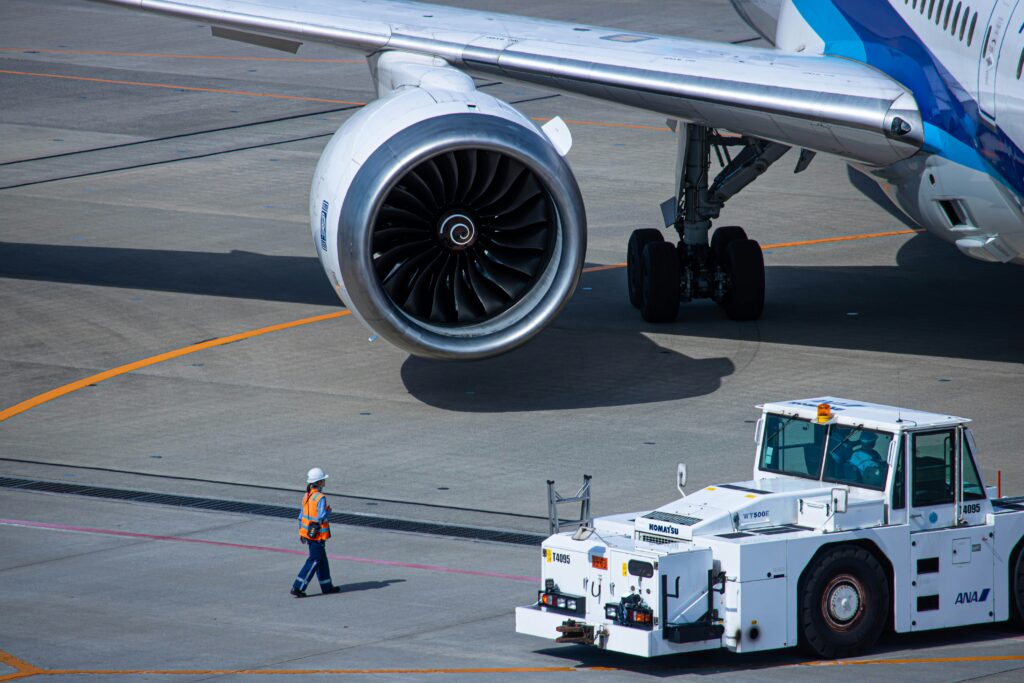For travelers relaxing in the business class lounges of most major airports, the intricate dance of airside service vehicles moving among arriving and departing jetliners can be a constant source of entertainment. A swarm of tugs, caterers, fueling trucks, baggage loaders, buses, and vans constantly circle the apron during most hours of operation.
With the post-pandemic spike in travel and increasing sensitivity to aviation’s carbon footprint, the industry is turning its attention to CO2 emissions from these ground operations as a way to meet climate goals looming in the decades ahead. These initiatives are getting a boost with the passage of the Federal Aviation Administration‘s Reauthorization Act in March.

Photo: Detroit International Airport. Courtesy of Hanson-Lu / Unsplash
“The recent passage of the FAA Reauthorization Act of 2024 offers a significant opportunity to advance sustainable transportation within the aviation sector,” writes Will Handke, managing consultant at the non-profit Center for Transportation and the Environment. “Notably, the Act prioritizes airports that develop comprehensive management plans for zero-emission vehicles and equipment.”
The Push for Sustainability
Several sections of the act expand the scope of projects eligible for airport improvement funding to promote facility sustainability and environmental resiliency, including acquiring low-emission vehicles, developing low-emission fuel systems, and related air-quality improvements.
“Traditionally, the aviation industry’s carbon footprint calculations have excluded ground-handling and people-mover operations, focusing instead on in-flight emissions,” says David Michery, CEO and chairman of commercial EV maker Mullen Automotive. “It’s encouraging, however, that the sector and its stakeholders increasingly recognize the significant environmental impact of ground operations.”

Photo: Terminal TBIT. Courtesy of Los Angeles International Airport / Joshua Sudock
Last year, Mullen inked a partnership with British Airways to introduce its Campus EV cargo vans for the airline’s operations at Los Angeles International Airport (LAX) and Chicago O’Hare (ORD), Michery says. The pilot program at LAX “demonstrated an 83 percent reduction in CO2 emissions compared to gas-powered equivalents,” he says.
In addition to pilot programs using electric ground service vehicles at LAX and ORD, British Airways has announced a multi-million-pound investment in more sustainable ground equipment at London Heathrow (LHR). The airline says the program will gradually transition to zero-emissions or hybrid equipment, including buses, baggage tugs, cargo-loading vehicles, and aircraft steps.

Photo: London Heathrow Airport, Terminal 5. Photo. Courtesy of BAA Airports Limited.
Tom Moran, director of Heathrow for British Airways, says, “This major investment into our vehicles at Heathrow is our largest investment in more sustainable airport ground operations to date and is part of our wider environmental objective to minimize emissions from our airside ground operation.”
Electrifying Opportunities
As airlines and aircraft manufacturers continue to grapple with the monumental technical challenges of reducing the industry’s in-flight emissions, a transition to more sustainable ground operations is one area where aviation can post substantial progress on the way to net zero carbon.
The reason, according to Handke, is an airport’s high-volume vehicle usage in a relatively concentrated footprint. “Airports offer a prime opportunity to electrify ground vehicles now,” he says, noting that these vehicles are used by trained operators and share maintenance and fueling facilities within a limited space.

Photo: Courtesy of Ryuno Ba / Unsplash
“What’s more,” Handke adds, “airport vehicles operate around the clock, making them some of the more emissions-intensive vehicles in the United States. These unique aspects of airport vehicles make it possible to implement rapid and cost-effective zero-emission transition plans.”
Michery cautions that fielding a totally electric airport vehicle fleet will require a significant upfront investment, but the long-term operational savings from reduced fuel consumption and maintenance can offset the initial costs. However, a successful transition to more sustainable ground operations starts with effective airport infrastructure planning.
To achieve this, Michery says, a collaborative approach is necessary. “Airports, ground handling service providers, and vehicle manufacturers must work together to invest in the charging infrastructure and grid enhancements that will nurture an EV ecosystem.”





